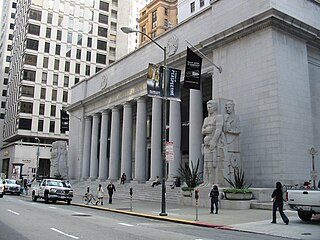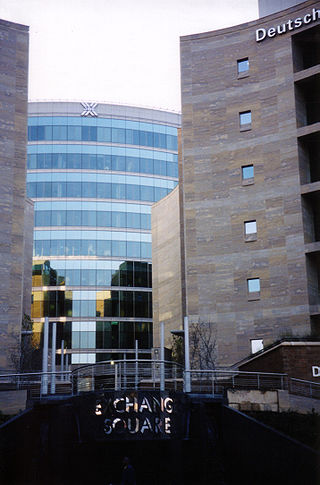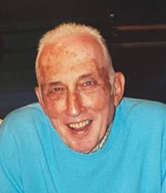
NYSE American, formerly known as the American Stock Exchange (AMEX), and more recently as NYSE MKT, is an American stock exchange situated in New York City. AMEX was previously a mutual organization, owned by its members. Until 1953, it was known as the New York Curb Exchange.

The New York Stock Exchange is an American stock exchange in the Financial District of Lower Manhattan in New York City. It is by far the world's largest stock exchange by market capitalization of its listed companies at US$30.1 trillion as of February 2018. The average daily trading value was approximately US$169 billion in 2013. The NYSE trading floor is at the New York Stock Exchange Building on 11 Wall Street and 18 Broad Street and is a National Historic Landmark. An additional trading room, at 30 Broad Street, was closed in February 2007.

Australian Securities Exchange Ltd or ASX, is an Australian public company that operates Australia's primary securities exchange, the Australian Securities Exchange. The ASX was formed on 1 April 1987, through incorporation under legislation of the Australian Parliament as an amalgamation of the six state securities exchanges, and merged with the Sydney Futures Exchange in 2006.

The Toronto Stock Exchange is a stock exchange located in Toronto, Ontario, Canada. It is the 10th largest exchange in the world and the third largest in North America based on market capitalization. Based in the EY Tower in Toronto's Financial District, the TSX is a wholly owned subsidiary of the TMX Group for the trading of senior equities. A broad range of businesses from Canada and abroad are represented on the exchange. In addition to conventional securities, the exchange lists various exchange-traded funds, split share corporations, income trusts and investment funds. More mining and oil and gas companies are listed on Toronto Stock Exchange than any other stock exchange.

The Pacific Exchange was a regional stock exchange in California, from 1956 to 2006. Its main exchange floor and building were in San Francisco, California, with a branch building in Los Angeles, California.

The Tel Aviv Stock Exchange is Israel's only public stock exchange and a public company that has been traded on the Tel-Aviv Stock Exchange since August 1, 2019. Legally, the exchange is regulated by the Securities Law (1968), and is under the direct supervision of the Israel Securities Authority (ISA).

JSE Limited is the largest stock exchange in Africa. It is located in Sandton, Johannesburg, South Africa, after it moved from downtown Johannesburg in 2000. In 2003 the JSE had an estimated 473 listed companies and a market capitalisation of US$182.6 billion, as well as an average monthly traded value of US$6.399 billion. As of March 2022, the market capitalisation of the JSE was at US$1.36 trillion.

The Philippine Stock Exchange, Inc. is the national stock exchange of the Philippines. The exchange was created in 1992 from the merger of the Manila Stock Exchange and the Makati Stock Exchange. Including previous forms, the exchange has been in operation since 1927.

Budapest Stock Exchange(BSE) is the 2nd largest stock exchange in Central and Eastern Europe by market capitalization and liquidity. It is located at 55 Krisztina Boulevard, Budapest, Hungary, in the Buda Centre of the Hungarian National Bank Previously, from 1864, during the Austro-Hungarian Empire it was located in the Budapest Stock Exchange Palace building, until a large trading floor was necessary. The exchange is controlled by listed issuers, by Hungarian private investors and by the central bank. The BSE is member of the World Federation of Exchanges and the Federation of European Securities Exchanges.

Broad Street is a north–south street in the Financial District of Lower Manhattan in New York City. Originally the Broad Canal in New Amsterdam, it stretches from today's South Street to Wall Street.
A trading curb is a financial regulatory instrument that is in place to prevent stock market crashes from occurring, and is implemented by the relevant stock exchange organization. Since their inception, circuit breakers have been modified to prevent both speculative gains and dramatic losses within a small time frame. When triggered, circuit breakers either stop trading for a small amount of time or close trading early in order to allow accurate information to flow among market makers and for institutional traders to assess their positions and make rational decisions.
A regional stock exchange is a term used in the United States to describe stock exchanges that operate outside of the country's main financial center in New York City. A regional stock exchange operates in the trading of listed and over-the-counter (OTC) equities under the SEC's Unlisted Trading Privileges (UTP) rule.

The phrase curbstone broker or curb-stone broker refers to a broker who conducts trading on the literal curbs of a financial district. Such brokers were prevalent in the 1800s and early 1900s, and the most famous curb market existed on Broad Street in the financial district of Manhattan. Curbstone brokers often traded stocks that were speculative in nature, as well as stocks in small industrial companies such as iron, textiles and chemicals. Efforts to organize and standardize the market started early in the 20th century under notable curb-stone brokers such as Emanuel S. Mendels.

The American Stock Exchange Building, formerly known as the New York Curb Exchange Building and also known as 86 Trinity Place or 123 Greenwich Street, is the former headquarters of the American Stock Exchange. Designed in two sections by Starrett & van Vleck, it is located between Greenwich Street and Trinity Place in the Financial District of Lower Manhattan in New York City, with its main entrance at Trinity Place. The building represents a link to the historical practices of stock trading outside the strictures of the New York Stock Exchange (NYSE), which took place outdoors "on the curb" prior to the construction of the structure.

The San Francisco Stock and Bond Exchange was a regional stock exchange based in San Francisco, California, United States. Founded in 1882, in 1928 the exchange purchased and began using the name San Francisco Stock Exchange, while the old San Francisco Stock Exchange was renamed the San Francisco Mining Exchange. The San Francisco Curb Exchange was absorbed by the San Francisco Stock Exchange in 1938. In 1956 the San Francisco Stock Exchange merged with the Los Angeles Oil Exchange to create the Pacific Coast Stock Exchange.

The San Francisco Curb Exchange was a curb exchange opened in 1928, formed out of a re-organization of the San Francisco Stock and Bond Exchange and the San Francisco Mining Exchange. The San Francisco Curb Exchange replaced the Mining Exchange at the 350 Bush Street building. The Curb Exchange later left the building in 1938, when the Curb Exchange was absorbed by the San Francisco Stock Exchange.

Robert Jack Birnbaum was an American financial executive who served as president of the American Stock Exchange and president of the New York Stock Exchange. He was the president of the NYSE during the Stock market crash of 1987, dubbed Black Monday. He contributed to the adoption of changes in the exchange's operations after the event, including circuit breakers as trade curbing mechanisms during periods of intense volatility. Birnbaum had earlier worked for the Securities Exchange Commission, where his studies recommended the introduction of the forerunner of the modern National Market System in securities trading.

The New York Stock Exchange Building, in the Financial District of Lower Manhattan in New York City, serves as the headquarters of the New York Stock Exchange (NYSE). It is composed of two connected structures occupying part of the city block bounded by Wall Street, Broad Street, New Street, and Exchange Place. The central section of the block contains the original structure at 18 Broad Street, designed in the Classical Revival style by George B. Post. The northern section contains a 23-story office annex at 11 Wall Street, designed by Trowbridge & Livingston in a similar style.















